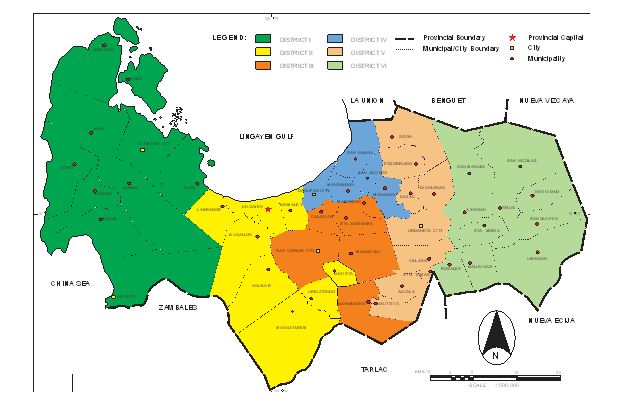PANGASINAN PROFILE
HISTORY
Pangasinan was among the earliest political and administrative units in the Philippines. It was officially conquered and colonized by D. Martin de Goite in 1571. On April 5, 1572, Pangasinan was made an encomienda by the Spanish royal crown to receive instructions on the Catholic faith, which means that Pangasinan was organized under one leadership and has identity before the Spanish royal court. Eight years later, in 1580, Pangasinan was organized into a political unit under an alkalde mayor who at that time has authority as head of province or provincial government with judicial function indicating that Pangasinan has become a province. To commemorate the day when Pangasinan became an encomienda and the year it became a province, Pangasinan celebrates April 5, 1580 as the official founding day of the province of Pangasinan. At that time, its territorial jurisdiction included the province of Zambales and parts of La Union and Tarlac. By the middle of the 19th century however, the northern towns of Agoo to Bacnotan were separated from the province and became parts of La Union. The provincial territory was further diminished in 1875 with the annexation of Paniqui and other towns south of it to Tarlac. The province has derived its name from the word “panag-asinan”, which figuratively means “where salt is made”, owing to the rich and fine salt beds which were the prior source of livelihood of the province’s coastal towns.
GEOGRAPHIC PROFILE
It is located on the northwest portion of the Central Plains of Luzon and is bounded in the north by Lingayen Gulf, La Union and Benguet, in the northeast by Nueva Viscaya, in the east by Nueva Ecija, Tarlac in the south and Zambales and China Sea in the west.
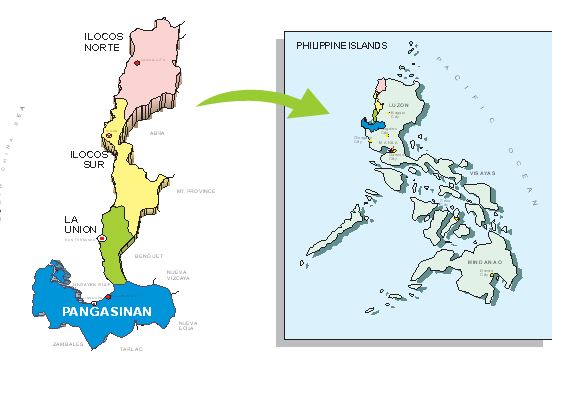 |
It is approximately 170 kms. from Manila and it takes about four hours to reach Pangasinan by bus, passing through the Manila North Road or through Tarlac via the Romulo Highway or the Olongapo-Alaminos-Bugallon road via Zambales and ppassing through Tarclac-Pangasinan-La Union Expressway (TPLEX) via Subic Clark-Tarlac Expressway (SCTEX). Aircon and ordinary buses ply the route 24 hours daily. It has extensive road network strategically located at the crossroads of a national road network interlinked with other regions and has the highest share in the total regional road length. Due to its accessibility, it is known as “gateway of opportunities” to the north as the province situates big commercial and financial centers for commerce and trade industries.
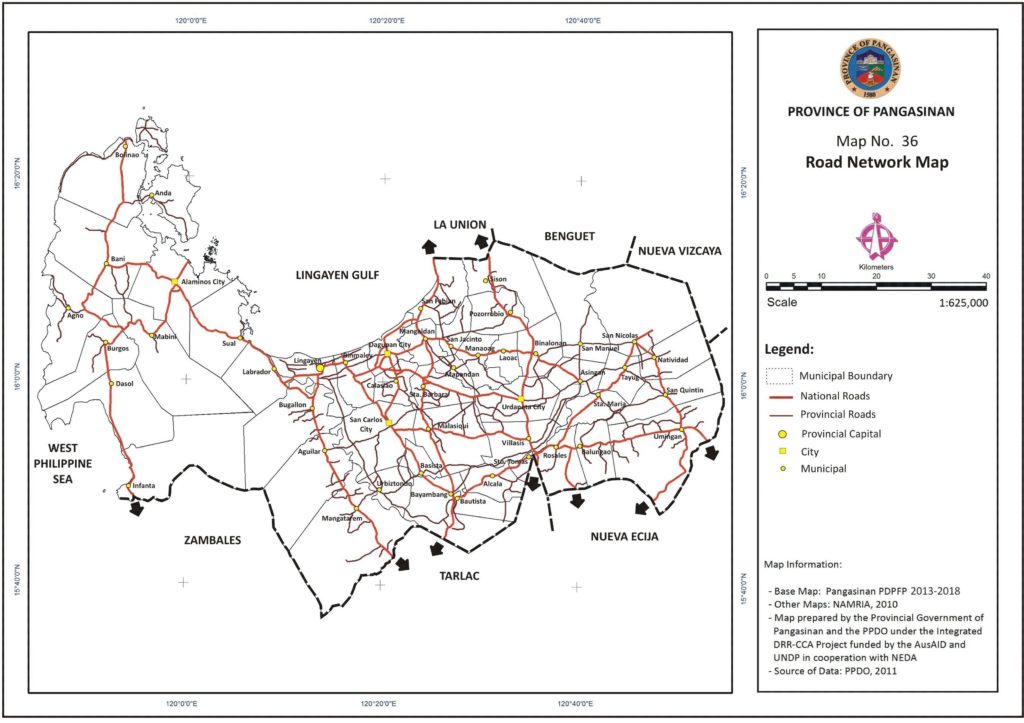 |
The province has a total land area of 545,101 hectares, which constitute almost one-half (41.8%) of the total land area of the region (1,301,260 has.) and 1.6% of the total Philippine area ( 34,344,832 has.). It is comprised of 44 municipalities, 4 cities, and 1,364 barangays. It has 6 Congressional Districts with Lingayen as the Provincial Capital.
|
|
It is rich with innumerable natural and man-made attractions and offers tremendous opportunities appropriate for tourist and prospective investors. It is a place of most exciting wonders of nature in Hundred Islands, and many other natural attractions such as waterfalls, hot springs and hidden bays that nature lovers surely enjoy. It is also known as land of miracle because of the presence of many spiritual land marks like the Minor Basilica of our Lady Manaoag, Señor Divino Tesoro in Calasiao and the historic churches in Bolinao and San Fabian, among others.
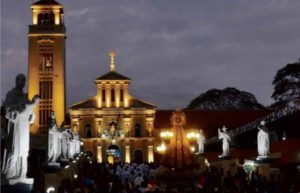 |
 |
 |
The province’s land area comprises the alienable and disposable land and the forest lands. The existing land use of the province is dominated by agriculture, which is mostly located in the Central and Eastern part and the coastal areas of Western Pangasinan.
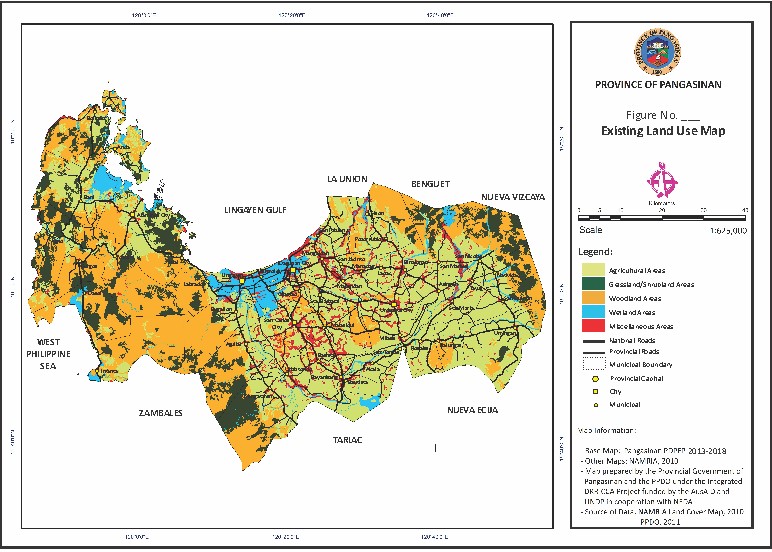 |
DEMOGRAPHIC PROFILE
Based from the 2015 Census of Population, Pangasinan has a population of 2,956,726 accounting for more than one-half of the total regional population. It is the fourth (4th) most populous province in the country, growing at an average rate of 1.18% person annually from 2010 – 2015. With a projected population (2016) of 2,991,849, the computed population density is 549 persons per square kilometer of land, higher than the regional and national density of 391 and 299 persons per square kilometer, respectively.
Among the 48 cities and municipalities, San Carlos City has the largest population with 188,571 persons, followed by Dagupan City (171,271), Urdaneta City (132,940) and the Municipalities of Malasiqui (130,275) and Bayambang (118,205). On the other hand, the Municipality of Sto.Tomas is the least populated area, based on the 2015 Census of Population.
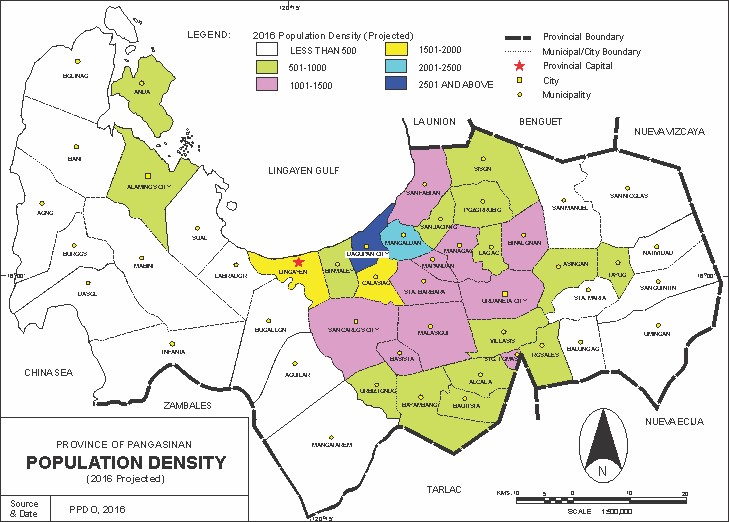 |
| CENSUS OF POPULATION BY CITY/MUNICIPALITY/DISTRICT PROVINCE OF PANGASINAN CY 2000, 2007, 2010, 2015 |
 |
SOCIAL PROFILE
There are two dialects spoken in the province. The Pangasinan dialect is common to the households in the central part of the province, while the eastern and the western portion speak Ilokano. English and Filipino are language used in government, school and business. Roman Catholic is the prevalent religion in the area.
In education which is an indispensable component of development, Pangasinan has a total of 1,970 elementary and secondary public and private learning institutions for SY 2016-2017 and 153 tertiary schools including technical/vocational institutions for the same period.
Health care services are provided by 59 public and private hospitals with a total bed capacity of 862 for government and 1,314 for private hospitals. In addition, the province has 69 Rural Health Units (RHUs) and 580 Barangay Health Stations (BHS) complementing health service delivery to the populace.
The province’s employment rate is 94.60, while the unemployment rate and underemployment rate is 5.40 and 16.19, respectively. For the daily minimum wage rate, as of October, 2016, the highest minimum wage rate is given by the Large Non-Agricultural Industries and Commercial Fishing Sectors.
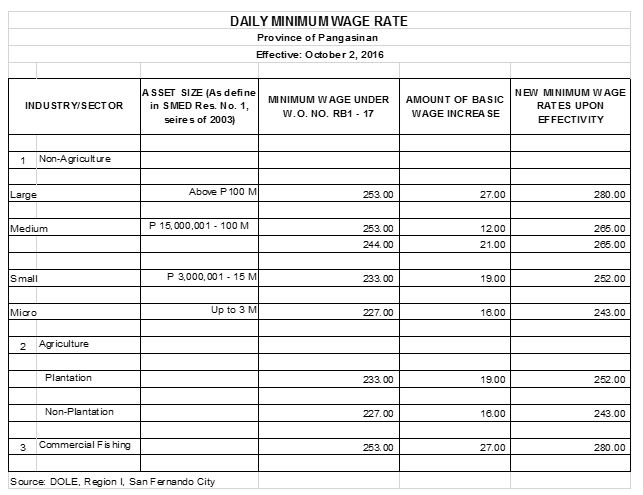 |
ECONOMIC PROFILE
Pangasinan’s vast tract of fertile land is suitable for growing high value crops such as palay, corn, vegetable, fruits and rootcrops. The province remains as the leading palay and corn producers in the region. It is also, the leading producer of high quality of agricultural crops, particularly mango, which has contributed the largest share of 75.5% of the fruit production in the province. Likewise, it has an extensive coastal marine and inland fishery area for aquaculture development, making the province the major fish producer and supplier in Northern Luzon, particularly our world’s tastiest milkfish (bangus). With the total fishery production of 128,885.039 MT in 2016, the province posted a high sufficiency level of 117%.
Based on the 2016 records of DTI-Dagupan, the province has a total of 9,200 micro enterprises and some 8,690 registered establishments. Dominating the establishments are the personal services and trading sectors, while the industrial services sector has the least. Pangasinan also has a total of 27 registered Call Centers / Business Process Outsourcing (BPO).
 |
As of CY 2016, there are 831 financial institutions operating in the province, with Pawnshops having the most number with 530, followed by various types of banks with 290 and 11 non-banking institutions strategically located provincewide.
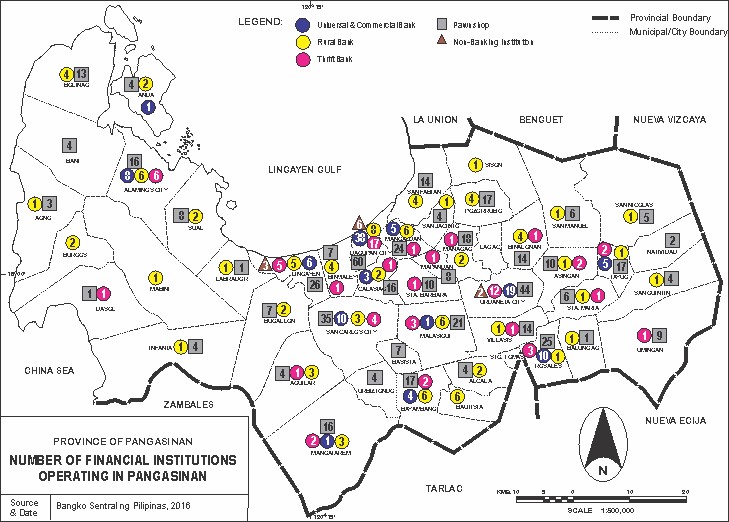 |

